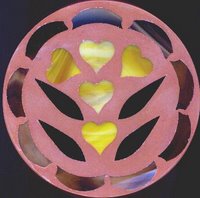
Tools and accessories you use for stepping stone construction should be strictly designated for stepping stone work. Do not use any of the following items later (even after washing) for food preparation, food serving or food storage. Keep all items separate and for use only with your concrete.
You will need
•Two large mixing buckets. 10 gallon plastic paint containers are more than adequate and are what I use when mixing for a large stone. Other favorites come from the local bakery where the containers have held the likes of corn syrup or baking mix. Sometimes these buckets are free. Sometimes the bakeries sell them for a dollar or two. Of course, there’s nothing wrong with a trip to the hardware store for a traditional metal bucket. They work too!
•Medium sized mixing buckets. 5 gallon size containers are handy for mixing trivets.
•A smaller container. Got margarine? A three pound plastic container is perfect for mixing trivets
•Measuring cups. Two sets, metal or plastic. Both will work. One set is used for dry measuring, one set for water.
•Measuring spoons. Again, metal or plastic.
•A paint stir. If you’ve ever purchased paint, you’ve probably got a few million of these lying around. Wood or plastic. It’s all good. And free.
•Rubber gloves. Cement mix is extremely abrasive and tough on the hands.
•Dust Mask
•Safety Glasses
•A glass cutter, if you plan to cut your own glass shapes.
•Running and/or breaking pliers, if you plan to cut your own glass shapes.
•Sandblasting resist or heavy contact paper (I prefer clear).
•Petroleum jelly
•Scissors, pattern scissors, or an exacto knife
•Marking pen
•Spray adhesive or glue stick
•Paper
•A pattern
•Mold (the plastic type, not the penicillin type)
•Assorted stained glass
•Newspaper
•Level
•DiamondCRETE
•6 – 8 Pencils
Optional items
Handy if you have them, but not required:
• Glass Grinder
• Mosaic Cutter
• Reflective Tape (which might be optional depending on the type of glass you use.
• Grozing Stone (cheaper than a grinder and you can use it to abrade any edges that need it.
Some folks like to have an electric drill with a paint stir attached. I personally don’t recommend it. It adds far too many bubbles to the mix and unless you come up with a way to get all of them out before your concrete mix sets up, you risk a stone that is riddled with tiny air bubbles and is thereby weakened. Use those rubber gloves and get in there with your hands. You can then feel for clumps or areas that need more blending and mixing.
Stay tuned for the next installment!